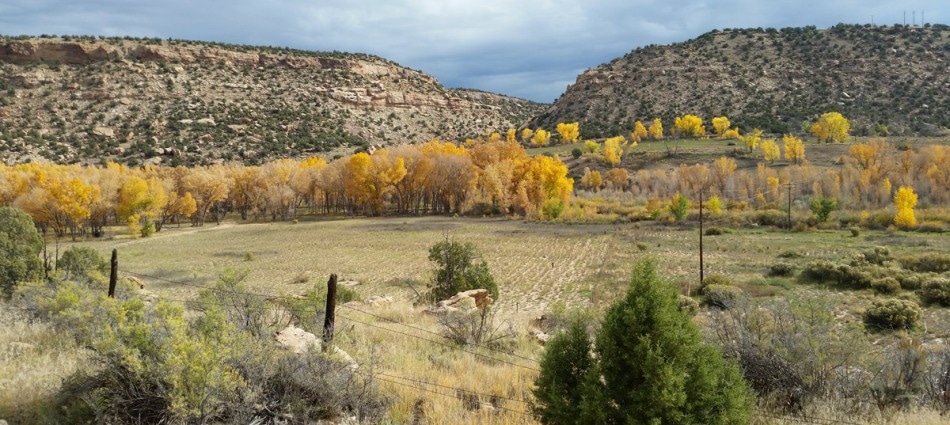May 2 2017
 A new study uncovered a previously unknown mechanism that explains why microbes sometimes fail to break down buried plant and animal matter. Above, the field site in the floodplains in the upper Colorado River Basin where soil samples were taken. (Image credit: John Bargar)
A new study uncovered a previously unknown mechanism that explains why microbes sometimes fail to break down buried plant and animal matter. Above, the field site in the floodplains in the upper Colorado River Basin where soil samples were taken. (Image credit: John Bargar)
An astounding amount of carbon can be present in the soils and sediments, which is much higher than the carbon content present in the atmosphere and plants in the world collectively and represents a major potential source of carbon dioxide – a greenhouse gas.
In a recent research reported in the Nature Geoscience journal, scientists from the Stanford University have found a new mechanism that describes why microbes are sometimes not able to break down all the animal and plant matter, leaving carbon underfoot. Gaining knowledge about where, and how long, the buried organic matter stays behind is important for researchers and policymakers to predict and react to climate change in a better manner.
Our picture of how organic matter is broken down in soils and sediments is incomplete. With this study, we are gaining new insights into the mechanisms of carbon preservation in low- or no-oxygen subterranean environments.
Kristin Boye, Associate Staff Scientist at the Stanford Synchrotron Radiation Lightsource, SLAC National Accelerator Laboratory
According to the researchers, the available organic matter in floodplains and in oxygen-starved places such as marshes is not equally broken down by the microorganisms. As a result, carbon compounds that do not offer adequate energy required for microbes to degrade get accumulated. However, this passed-over carbon does not need to remain in underground in the long term. Since carbon is water soluble, it can reach nearby oxygen-rich waterways, where it can be readily consumed by microorganisms.
Until today, models of local ecosystems and broader climate change have not considered this newly found carbon preservation mechanism as they have focused mainly on the availability of other elements and microbial enzymes for organic matter breakdown.
Soils and sediments are a huge and dynamic reservoir of carbon. That’s why we worry about turnover times here with regard to how fast organic carbon is degraded and released as carbon dioxide into the atmosphere.
Scott Fendorf, Professor of Soil Biogeochemistry, Stanford Earth
Tracking the fate of the carbon
For this study titled, “Thermodynamically controlled preservation of organic carbon in floodplains,” samples of buried sediments were collected from four floodplains situated in the upper Colorado River Basin in New Mexico and Colorado.
These column-shaped samples had a length of approximately 3 feet, reaching oxygen-starved layers where microorganisms need to switch from doing the microbial equivalent of breathing oxygen to breathing sulfur. In both the cases, the microorganisms combine sulfur or oxygen with carbon-based food to generate energy and discharge either sulfur dioxide or carbon dioxide into the atmosphere. The sulfur dioxide released to the atmosphere is the reason behind the characteristic smell of oxygen-poor wetlands.
The research team used the Stanford Synchrotron Radiation Lightsource facility to determine where the microorganisms had made the switch in the sediment samples. When the samples were exposed to the extremely bright X-ray light generated by the synchrotron machine, a signal was generated to reveal the chemistry of the sulfur. The existence of sulfide minerals signifies where the microorganisms started utilizing sulfur and carbon to produce energy for their biochemical machinery.
The researchers wanted to know the influence of the switch to sulfur on the carbon sources the microorganisms consumed or left behind, with the help of unique instrumentation and partnerships within the Environmental Molecular Sciences Laboratory at the Pacific Northwest National Laboratory in Richmond, Washington. The water-soluble organic material was characterized using a mass spectrometer with the help of a very strong magnet. The results revealed that unlike the layers containing oxygen, leftover carbon compounds in the samples where the microbes used sulfur for respiration were predominantly those that require more energy for degradation than would be released through the degradation itself. Of no use, then, to growing microorganisms, these compounds were detained within the deeper sediment layers.
Honing models of the carbon cycle
Floodplains, like the samples studied in this research work, are one of the most common areas across the world where animal and plant matter is detained by water-borne sediments. The oxygen-poor conditions created underground there are known for carbon sequestration, but the researchers suggest, partly for previously unknown reasons and with unexpected consequences. By definition, such flood-prone, low-lying areas are located nearby waterways. Through an aerated waterway, soluble, unused organic matter can easily migrate for subsequent breakdown, causing water quality issues such as algae blooms while also triggering carbon dioxide production.
Models of how the ground, living organisms, atmosphere recycle carbon, and bodies of water will increasingly demand to include key nuances, such as the preservation mechanism explained in this work, in order to inform researchers’ understanding and policymakers’ decisions.
Getting the constraints right on what really controls the processes of carbon breakdown is essential. That’s what our study helps illuminate.
Scott Fendorf, Professor of Soil Biogeochemistry, Stanford Earth
Other co-authors on the study include Malak Tfaily of the Pacific Northwest National Laboratory; Vincent Noel, Sharon Bone and John Bargar of the SLAC National Accelerator Laboratory; and Kenneth Williams of the Lawrence Berkeley National Laboratory.
The U.S. Department of Energy, the Office of Biological and Environmental Research, the SLAC National Accelerator Laboratory and the Lawrence Berkeley National Laboratory provided funding to this study.